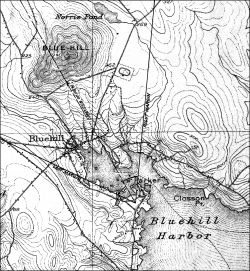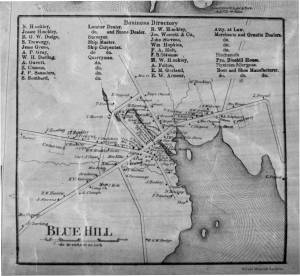An online project under the direction of the CAPE ANN MUSEUM
inv. 261
View of Blue Hill, Maine
Blue Hill, Maine
c. 1850 Oil on canvas 20 1/8 x 30 in. (51.1 x 76.2 cm)
Private collection, Washington, D.C.
|
Related Work in the Catalog
Supplementary Images
Explore catalog entries by keywords view all keywords »
Historical Materials
Below is historical information related to the Lane work above. To see complete information on a subject on the Historical Materials page, click on the subject name (in bold and underlined).
Blue Hill is a community east of Castine, across the water from Mount Desert, with a protected harbor. The hill which gives the town its name can also be seen from Castine. In 1850 the population was 1939 (Maine Register). Blue Hill had a fair amount of ship-building, but also quarrying and shipping of granite. According to the 1855 Maine Register, "There is shipped from Bluehill from twenty to fifty thousand dollars worth of rough and hewed granite, per annum." (1)
Awan-adjo, from "Awan," "fog and mist," and "-adjo, "lone hill of the sugar loaf type," perhaps of recent origin, or "K'chi-awan-adn-ock," "the big hazy mountain," was a landmark for the Wabenaki traveling to and fro along the "Minnewo'kun." Parson Jonathan Fisher called it Bluehill in his journal of April 1, 1809. The 934 foot "mountain" appears to be hazy or blue, depending upon your fancy, as you gaze upon its heights from the sea. Township 5, as it was designated in the survey of 1762, sits on Bluehill Bay, but it was not until 1788 that the citizens decided to rename the town Bluehill. The Act of Incorporation spelled the name Blue Hill, and this has led to a continual controversy over the name, as some still prefer Bluehill over Blue Hill.
"There is here a remarkable neat little village chiefly of farmers and the lands are good," so wrote Alexander Baring of London of his grand tour of North America, from the Hudson River to the St. Lawrence, and from the St. Lawrence and the St. John River to the Downeast Coast in 1797. This neat little village opened its own Bluehill Academy in 1803, providing an excellent education in science, mathematics, language, history, and literature for both young men and women, and published its own newspaper 1830-32. Joseph Wood and John Roundy arrived at Bluehill Bay on April 7, 1762, from Beverly, MA, and commenced getting out staves near Fore Falls. By 1768 lumber was being shipped to the West Indies. The Carleton brothers built a tide sawmill near the Salt Pond in 1770. As with every community Downeast, sawmills, fish houses, shipyards, and small, tidy farms were quickly established, and by the 1850s, Bluehill had blossomed into a neat, prosperous village of mariners, farmers, merchants, shipwrights, and millmen.
– Mark Honey
Reference:
1. George Adams. The Maine Register for the Year 1855, p.258
Also see:
Fannie Hardy Eckstrom, Indian Place-Names of the Penobscot Valley and the Maine Coast, University of Maine Studies, 2nd Series, #55, November 1941, reprinted 1960 by the University of Maine Press. DeLorme's Atlas, Frank G Speck's Penobscot Man, University Of Pennsylvania Press, 1940, and Eckstorm, among others, provide useful information on Minnewo'kun.
William Hinckley (1913–83), Bits of Local History, a compendium of re-published articles originally written for "The Weekly Packet" of Bluehill. As printed April 17, 1975 and August 11, 1977
Mark E. Honey, "Abigail & Sarah Hawes of Castine," in Navigators & Educators, with Lois Moore Cyr, 1996.
Mark E. Honey, "King Pine, Queen Spruce, Jack Tar," in An Intimate History of Lumbering on the Union River, vols. 1–5. This source, in its entirety, lays down the foundation of Downeast Maine's unique culture which was built upon pine lumber and timber, the cod fisheries, coasting, shipbuilding, and the interrelationships of family and community.
Personal diary
Wilson Museum, Castine, Maine (A00060-1a-1h)
Description of an excursion taken by Joseph Stevens, Jr., Lane, Witherle, Samuel Adams, Jr., and George Tilden around the islands of Maine near Mt. Desert. The group hired the Sloop "Superior" which was owned by Pilot Getchell. In his diary, Witherle mentions multiple times that "Lane took a sketch" especially when the water was calm. Lane often stayed on board the boat, while the others went ashore.
Excerpts of the diary include:
August 16: "Lane has a knack for frying fish."
August 17: "leaving Lane to take a sketch, we took a climb."
August 19: "went to ascend one of the highest mountains. 3/4 the way up we had to wait – once in a while for Lane who with his crutches could not keep up with us – but got along faster than we thought possible . . .Lane got up about an hour after the rest of us."
The entire text is transcribed in an account published by the Wilson Museum.
View related Fitz Henry Lane catalog entries (6) »
Also filed under: "Superior" (Sloop) » // Adams, Samuel, Jr. » // Biographical information » // Castine » // Chronology » // Diaries / Ledgers / Etc. » // Mount Desert Island & Rock » // Somes Sound » // Stevens, Joseph, Jr. » // Tilden, George » // Witherle, William Howe »


Commentary
Lane did only a handful of true landscapes, where there is more land depicted than water. In spite of the relative few, they are all masterful and derive from his lithography training where he did numerous “town views” encompassing large sweeps of landscape in great detail. This view is of the town across the shallow bay with Blue Hill rising behind. It is a serene afternoon bathed in late summer light looking west from a community boat landing as the bay was too shallow for larger vessels near the town. Note Lane’s attention to the botanical detail of the pasture and shrubs in the foreground, every bit as compelling and accurate as his attention to the nautical detail of his ships.
This painting was one of two paintings commissioned by Edward Dyer Peters, a wealthy lumber merchant with business in Ellsworth, ME, and Boston (see Sailing off the Maine Coast, 1850 (inv. 305)). He had recently built a large mansion in Blue Hill which is the pink (brick) building in the distance just to the left of the foreground building’s roof in the distance. Blue Hill Bay near the town is tidal and too shallow for a working harbor, but there was an active shipbuilding industry along with lumber and granite exporting to points south.
Lane did a wonderfully precise drawing for this painting (Blue Hill, Maine, 1851 (inv. 244)) in August of 1851 on one of his Maine summer cruises along the coast with his friend Joseph Stevens.
–Sam Holdsworth
[+] See More